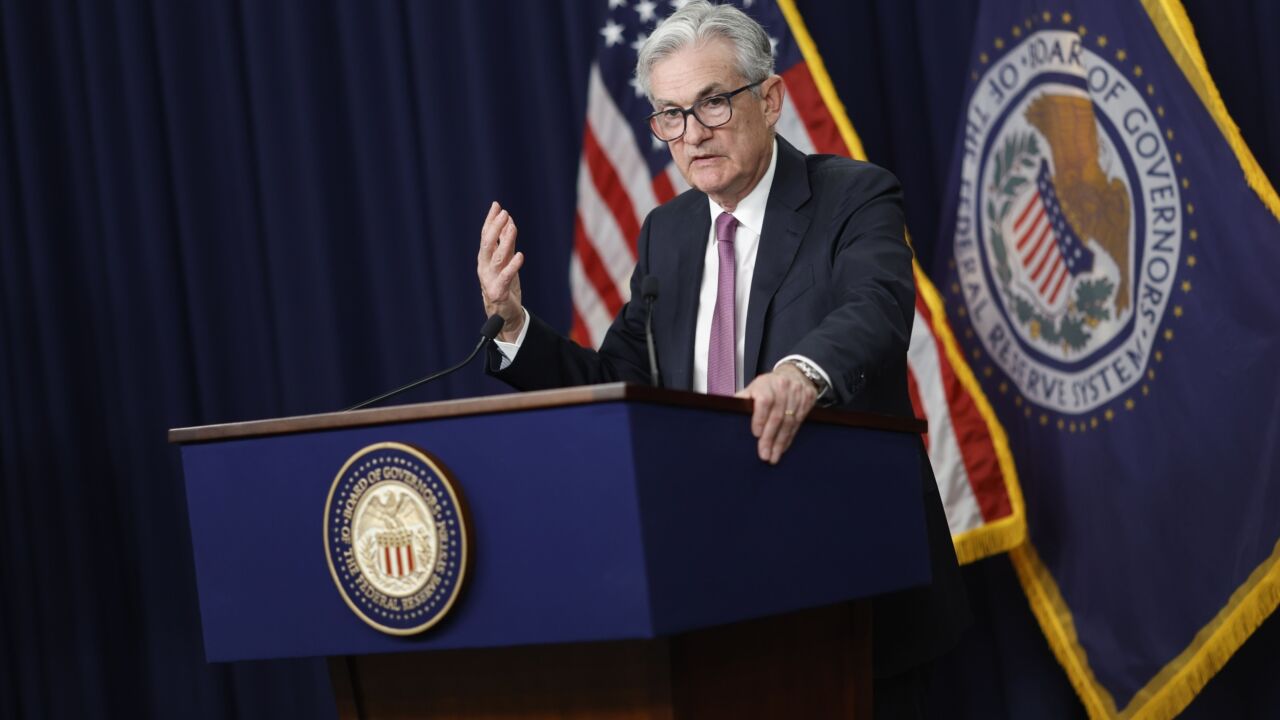
Banks with heavy commercial real estate concentrations got a reprieve in the market Friday following signals from Federal Reserve Chair Jerome Powell that the
The stock prices of community and regional banks with hefty exposures to the highly scrutinized CRE sector shot up by as much as 11% — substantially outpacing a 2.25% rise in the KBW Nasdaq Bank Index, which broadly tracks bank stocks. The prospect of easier monetary policy suggests both that funding costs at CRE-heavy banks may decrease and that their heaps of property loans may become less risky.
Investors flocked to real estate-focused banks — including Eagle Bancorp, Dime Community Bank, New York Community Bancorp, First Foundation and Valley National Bancorp — that they have eschewed for months
Powell said in a Friday morning speech that after the Fed maintained rates at a two-decade high of between 5.25% and 5.5% for more than a year, a change is coming.
"The time has come for policy to adjust," Powell said at the Federal Reserve Bank of Kansas City's Jackson Hole Economic Symposium. "The direction of travel is clear, and the timing and pace of rate cuts will depend on incoming data, the evolving outlook, and the balance of risks."
The long-awaited rate cuts are expected to help CRE-focused banks both by mitigating some of their credit risk and by boosting their earnings potential, said Adam Mustafa, co-founder and CEO of advisory firm Invictus Group.
Banks with outsize real estate exposure — often identified by how much their CRE books exceed a key regulatory threshold —
Shares in New York Community, which went into a notorious spiral earlier this year before being recapitalized, are down more than 60% in 2024. Eagle, First Foundation and Valley have lost between 18% and 30% of their valuations.
On Friday afternoon, New York Community was up around 8%, Eagle was up more than 10%, First Foundation was up nearly 7% and Valley was up close to 9%.
"Economic and interest rate uncertainties, particularly regarding office loans and other CRE exposures, have presented challenges," Eagle President and CEO Susan Riel said on the bank's second-quarter earnings call last month. "Our objective is to establish a strong foundation for sustainable growth, achieving improved and consistent profitability regardless of the interest rate environment."
Now, with more, albeit not complete, clarity about the trajectory of rates, investors seem to be placing bets on a soft landing, Mustafa said.
Lower rates would ease some pressure for borrowers who might otherwise strain to make debt payments when their loans mature in a far costlier environment than the near-zero-rates era when they were made.
Much of that debt is backed by real estate that has depreciated in value, in some cases by as much as 80%. If the banks take some losses, it would be less painful to investors in a lower-rate environment where alternatives to bank stocks look less attractive.
The rapid rise in rates since 2022 has also meant that banks have had to pay depositors much more, increasing the banks' cost of funding their own loans. This phenomenon has led to the compression of banks' net interest margins, especially at CRE-heavy banks, which tend to have a greater reliance on expensive funding sources, like brokered deposits.
"These banks are more sensitive to this higher cost of funding, which means on the way down, it will also be cheaper for them because so many of them are borrowing on the margin right now," Mustafa said. "They're going to get a benefit on the net interest margin that could be far more beneficial to them than even the benefit on the credit side."
In his speech at the Federal Reserve's Jackson Hole Economic Symposium, the Fed chair said employment losses are now a bigger risk than elevated inflation.
First Foundation in Dallas built a massive multifamily real estate loan book when rates were at their floor. But when its deposit costs surged, it faced a classic funding mismatch, since its fixed-rate loans weren't bringing in enough revenue to meet expenses.
After limping through several weak quarters of earnings, the
The question now is how much of a breather the banks will get.
On Friday afternoon, most traders seemed to expect a 25-basis-point rate decrease in September, according to the CME Group's FedWatch tool. Mustafa said that initial step would be "a drop in the bucket."
Projections further out are more mixed, with estimates for Fed cuts by the end of 2024 ranging between 75 and 150 basis points.
Markets seem "a bit optimistic," and may be disappointed if the Fed's moves are less aggressive, said Quincy Krosby, chief global strategist at LPL Financial. Fed officials
"Banks are better prepared for a gradual rise or gradual decline in interest rates," said Terry McEvoy, a managing director at Stephens. "If there is a pronounced move over a short period of time, that can create some challenges for companies, and we saw that on the way up. … I think there's a Goldilocks scenario of 'not too fast and not too kind of slow' that is perfect for the banks."
Plus, too much of a good thing can be a bad thing. A spate of rate cuts might imply weakness in the economy, which would bring its own set of challenges for banks.
"They need to have an economic backdrop that is healthy," Krosby said.
Polo Rocha contributed to this story.






